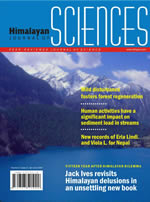Indigenous knowledge of terrace management in Paundi Khola watershed, Lamjung district, Nepal
DOI:
https://doi.org/10.3126/hjs.v2i3.228Keywords:
Terraces, watershed management, slope failure, bund plantation, slumpingAbstract
The study was carried out in the Paundi Khola watershed, Lamjung district, with the objective of evaluating the indigenous knowledge of terrace management. Various biophysical practices and land husbandry practices were recorded through field observation. A questionnaire survey and group discussions were also undertaken to acquire relevant information. It was found that terrace width and riser height correlated with slope angle negatively and positively, respectively. Outward-sloped terraces were common in the higher slope classes. Bund plantation was rarely observed in the irrigated fields. Paddy was the preferred crop wherever sufficient water was available. Paddy cultivation on unstable slopes without proper irrigation and drainage systems was the usual cause of slumping. Despite the failure of terraces or slopes in areas with deep-seated slides, farmers continued paddy cultivation by temporarily supporting and stabilizing the terraces until this was no longer feasible and major slope failure occurred. Gradual replacement of paddy by other more appropriate upland crops may sort out this problem to some extent. Key words: Terraces, watershed management, slope failure, bund plantation, slumping Himalayan Journal of Sciences 2(3): 33-36, 2004Downloads
Download data is not yet available.
Abstract
780
PDF
718
Downloads
How to Cite
Pandit, K., & Balla, M. K. (2006). Indigenous knowledge of terrace management in Paundi Khola watershed, Lamjung district, Nepal. Himalayan Journal of Sciences, 2(3), 33–36. https://doi.org/10.3126/hjs.v2i3.228
Issue
Section
Research Papers




